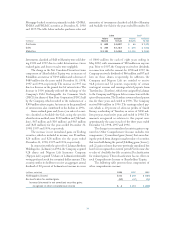American Express 1998 Annual Report Download - page 46
Download and view the complete annual report
Please find page 46 of the 1998 American Express annual report below. You can navigate through the pages in the report by either clicking on the pages listed below, or by using the keyword search tool below to find specific information within the annual report.
44
rate swaps are generally matched with the maturity dates
of the underlying assets and liabilities.
For interest rate swaps that are used for nontrading
purposes and meet the criteria for hedge accounting, inter-
est is accrued and reported in Other Receivables and
Interest and Dividends or Accounts Payable and Interest
Expense, as appropriate. Products used for trading pur-
poses are reported at fair value in Other Assets or Other
Liabilities, as appropriate, with unrealized gains and losses
recognized currently in Other Revenues.
AEFA uses interest rate caps, swaps and floors to
protect the margin between the interest rates earned on
investments and the interest rates credited to holders of
investment certificates and fixed annuities. Interest rate
caps, swaps and floors generally mature within five years.
The costs of interest rate caps and floors are reported in
Other Assets and amortized into Interest and Dividends
on a straight-line basis over the term of the contract;
benefits are recognized in income when earned.
In 1998, AEFA also began using interest rate swaps
to manage the level of 1999 fee income earned on the
management of fixed income securities in variable annu-
ities and mutual funds. These swaps are used for nontrading
purposes and meet the criteria for hedge accounting.
Interest is accrued and reported in Other Receivables or
Accounts Payable, as appropriate, and Management and
Distribution Fees.
See Note 4 for further information regarding the
Company’s use of interest rate products related to short-
and long-term debt obligations.
FOREIGN CURRENCY PRODUCTS
The Company uses foreign currency products primarily
to hedge net investments in foreign operations and to
manage transactions denominated in foreign currencies.
In addition, AEB enters into derivative contracts both to
meet the needs of its clients and, to a limited extent, for
trading purposes, including taking proprietary positions.
Foreign currency exposures are hedged, where prac-
tical and economical, through foreign currency contracts.
Foreign currency contracts involve the purchase and sale
of a designated currency at an agreed upon rate for set-
tlement on a specified date. Foreign currency forward
contracts generally mature within one year, whereas
foreign currency spot contracts generally settle within
two days.
For foreign currency products used to hedge net
investments in foreign operations, unrealized gains and
losses as well as related premiums and discounts are
reported in Shareholders’ Equity. For foreign currency
contracts related to transactions denominated in foreign
currencies, unrealized gains and losses are reported in
Other Assets and Other Commissions and Fees or Other
Liabilities and Other Expenses, as appropriate. Related
premiums and discounts are reported in Other Assets or
Other Liabilities, as appropriate, and amortized into
Interest Expense and Other Expenses over the term of the
contract. Foreign currency products used for trading pur-
poses are reported at fair value in Other Assets or Other
Liabilities, as appropriate, with unrealized gains and losses
recognized currently in Other Commissions and Fees.
The Company also uses foreign currency forward
contracts to hedge its firm commitments. In addition,
for selected major overseas markets, the Company uses
foreign currency forward contracts to hedge future
income, generally for periods not exceeding one year;
unrealized gains and losses are recognized currently in
income. In the latter part of 1998 and 1997, foreign cur-
rency forward contracts were both sold ($569 million
and $562 million, respectively) and purchased ($34 mil-
lion and $92 million, respectively) to manage a majority
of anticipated future cash flows in major overseas mar-
kets. The impact of these activities was not material.
OTHER PRODUCTS
Included in Other Products are purchased and written
index options used by AEFA to hedge against adverse
changes in the U.S. equities markets, which affect revenues
earned on assets under management. Index options are car-
ried at market value and included in Other Assets or Other
Liabilities, as appropriate. Gains and losses on these
options are deferred until the related revenues are earned.
At December 31, 1998 and 1997, the notional value of
these options was $1.2 billion and $1.0 billion, respectively.
OTHER OFF-BALANCE SHEET FINANCIAL
INSTRUMENTS
The Company’s other off-balance sheet financial instru-
ments principally relate to extending credit to satisfy the
needs of its clients. The contractual amount of these
instruments represents the maximum accounting loss the
Company would record assuming the contract amount
is fully utilized, the counterparty defaults and collateral
held is worthless. Management does not expect any
material adverse impact to the Company’s financial posi-
tion to result from these contracts.
December 31, (millions) 1998 1997
Unused Credit Available to Cardmembers $ 44,626 $ 37,668
Loan Commitments and Other Lines of Credit $ 1,197 $ 1,053
Standby Letters of Credit and Guarantees $ 1,270 $ 1,301
Commercial and Other Letters of Credit $400 $618
























